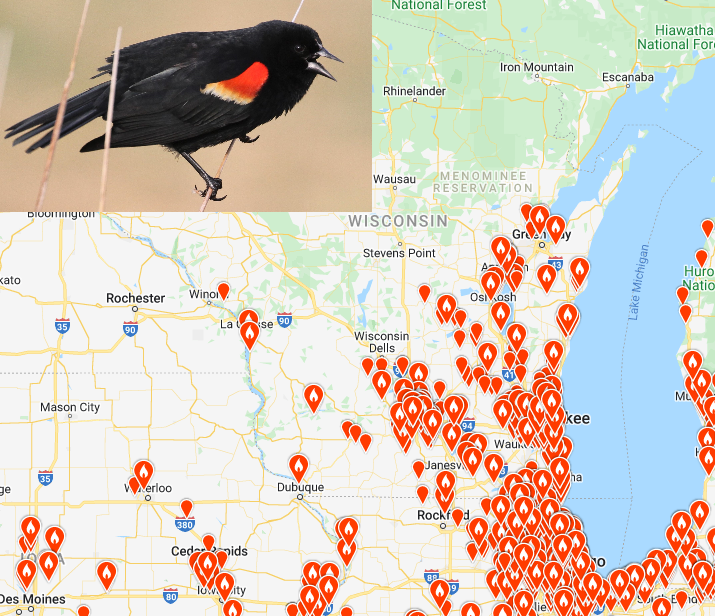Spring Migration Has Sprung!
Wisconsin is home to over 300 species of birds and thousands of birding enthusiasts. Explore the links below for information on birds, bird identification, birding locations and how to get involved in conservation efforts.
Sign up to receive the latest birding reports and other bird news here.
STATEWIDE BIRDING REPORT AS OF MARCH 4, 2022
Red-winged Blackbirds have arrived in some parts of the state, this map showing sightings reported to eBird since March 1. Add your sightings to the map and explore data for any species at www.ebird.org/wi.
Right on schedule, spring migration is underway! Sandhill cranes, Canada geese, red-winged blackbirds, American robins, killdeer, and other familiar feathered friends have begun their return to Wisconsin.
As usual, new birds are most evident across the southeast corner of the state, extending in decreasing numbers to Sauk, Columbia, Winnebago, and Brown counties, with some activity farther west north to La Crosse and Monroe. Other arrivals include common grackles, song sparrows, turkey vultures, horned larks, and eastern bluebirds, the latter investigating nest boxes already in some cases.
Waterbirds are on the move too. March is the best month of the year to see greater white-fronted geese in the state, and flocks of hundreds are starting to show up, often in the same places as Canada geese across southern counties. Waterfowl are also moving into areas of open water, including diving ducks such as redheads, scaup, bufflehead, and all three merganser species, as well as a variety of dabbling ducks, including mallards, pintails, wigeons, gadwalls, and more. Look for swans, great blue herons, and returning ring-billed gulls in these same areas.
Farther north, migration lags as expected. Trumpeter swans have been most apparent to date in the north woods, along with a few ducks, especially common goldeneye. Bald and golden eagles have just started to move overhead, their numbers to increase significantly over the next 2-3 weeks. A few herring gulls are also trickling back. Even though it looks much like winter, it certainly sounds more like spring. Black-capped chickadees are singing, woodpeckers are drumming, and feeder birds like redpolls, siskins, and goldfinches are very chatty this time of year as longer daylength kicks hormones into gear.
Statewide, redpolls remain very common, while siskins are more scattered and less abundant. Goldfinches are prevalent, some getting patches of brighter yellow now as the molt to summer breeding plumage begins. Maintaining a clean feeding area is very important this time of year as salmonellosis can be problematic and spreads quickly among flocks of small finches. Learn how to identify and manage the disease on the Wildlife Diseases webpage.
Pine grosbeaks continue across northern Wisconsin but will be departing soon, while white-winged crossbills remain widespread in small to moderate numbers throughout Wisconsin. Some may even stay to nest any time now, which would be unusual but not unprecedented.
In addition to eagles, look for pairs of red-tailed hawks and American kestrels, returning red-shouldered hawks and peregrine falcons, more turkey vultures, northern harriers, and merlins over the month ahead. Snowy and short-eared owls will begin to depart mid-March to mid-April. Farther south, great horned owls are well into nesting season now, females doing the bulk of incubation over a five-week period.
Where snow cover persists across the north and the threat of rain or mixed precipitation looms, barred and northern saw-whet owls may become more active in daylight as food becomes more difficult to access under a crusty surface layer.
Migration activity will ramp up with every passing week into late May, making this an exciting time for birders. Expect new birds in the south for the first half of the weekend, and then another shot of migrants into the middle of next week ahead of our next cold front, which stymies migration this time of year. Listen for increasing bird song, departure of some wintering species, and the arrival of American woodcock, meadowlarks, and other spring migrants.
Help us track the migration by reporting your observations to www.ebird.org/wi. Good birding!
– Ryan Brady, DNR Natural Heritage Conservation Program Biologist












